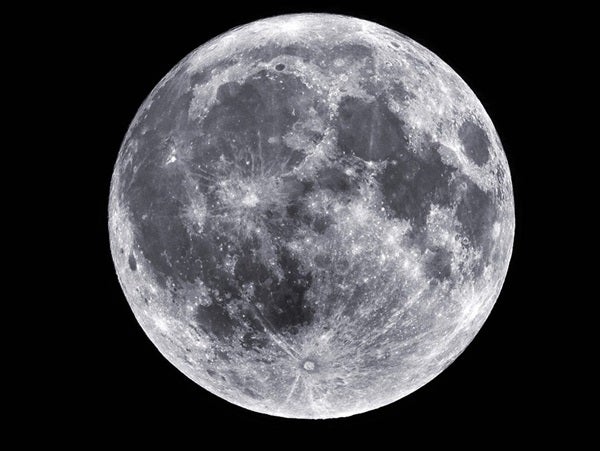Start with that quarter, held 9 feet away by your significant other. It’s the Moon’s size, but detail is hard to discern on a distant coin that’s uniformly silvery. The Moon’s actual blotchy “seas” stand out because their iron-rich composition makes them darker than their surroundings. So, use a marker and darken the bottom of George Washington’s long hairdo. Then fill in a dark triangle from George’s eyebrows to his cheeks. (I’m pretty sure these instructions have never appeared anywhere else.) These coin defacements match the visual size of the Moon’s larger maria, its dark blotches. On the real Full Moon, the largest round sea near the top is Mare Imbrium, as easy a naked-eye feature as our coin demo suggests.
Easy is the right adjective. The Moon appears six times bigger than the 20/20 letters on a standard Snellen chart. That’s because those eye chart letters are 5′ in height and width, compared with the Moon’s 30′ diameter. Of course, simply seeing those letters is not the test. The vision test is whether you can discern detail within each letter — brush strokes and spaces sized at 1′ apiece. If your eyes can indeed resolve a single arcminute, you’ll see the difference between the E and F on the chart’s eighth line. And you’ll detect a lunar feature just 1/30 the Moon’s width, a mere 72 miles (116 kilometers) across. Thus, normal vision lets you see the beautiful Bay of Rainbows near the top of the Moon, as well as the largest craters.
Astronomers crave the detail that maximum size delivers. That’s why this fall’s Mars opposition, with its wonderful 23″ disk, is so much better than the next opposition in 2022, when the Red Planet will be only 17″ wide. But sometimes observers want small size, not large. Can you think of when this might be true?
The answer is: seeing conditions! Major observatories monitor the hourly size of stars. Beyond Earth’s atmosphere, stars are pinpoints. That’s what Hubble sees. But earthly telescopes like yours and mine show star fields made of little blobs, with frustration proportional to their diameter.
Five more scraps remain on my desk, bearing random, desultory astro-ideas. Their contents:
- The most dangerous object to human life is Comet 109P/Swift–Tuttle, the parent of the Perseids. It’s big, it can come very close, and its orbit is steeply inclined to the ecliptic — giving it an unusually high speed through the inner solar system.
- The smallest deep-space object a backyard telescope owner might see is the Crab pulsar, which could fit within Los Angeles.
- Only three planets’ names can form anagrams, and all relate to the human body: Earth (heart), Mars (arms), and Venus (nevus, a mole or similar skin discoloration).
- My favorite rarely heard celestial term is exeligmos — the 54-year, one-month cycle after which the same eclipse recurs in your neighborhood.
- What’s the most barely happening celestial event that, oddly enough, everyone knows? It’s that Earth’s rotation is slowing. Because, after a whole century, our day has gotten just 1/700 of a second longer. It’s very unusual for the public to be aware of something so subtle.
Now I can toss those scraps, and wipe the Sharpie off that quarter-Moon.










